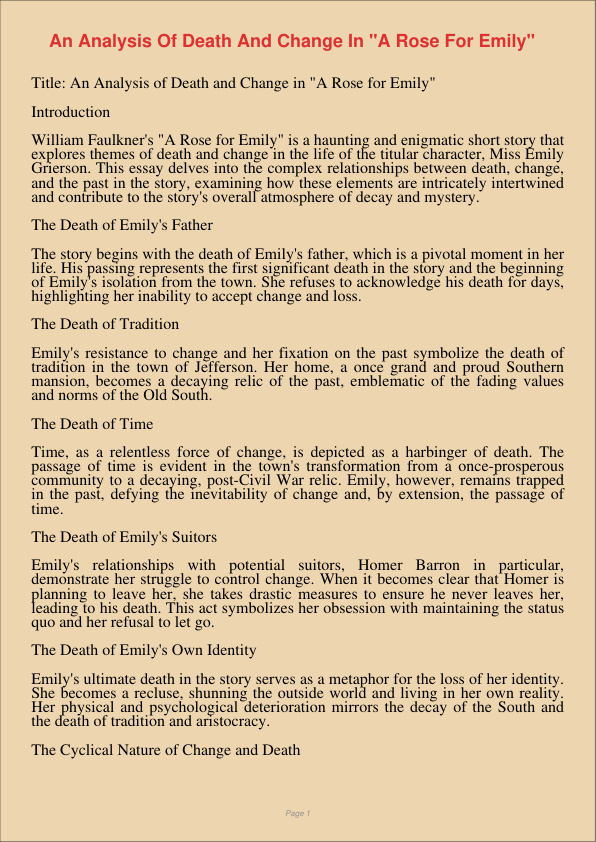An Analysis Of Death And Change In A Rose For Emily
Jan 9, 2024
rose
emily
Psychology
Journalism & Communication
Title: An Analysis of Death and Change in “A Rose for Emily”
Introduction
William Faulkner’s “A Rose for Emily” is a haunting and enigmatic short story that explores themes of death and change in the life of the titular character, Miss Emily Grierson. This essay delves into the complex relationships between death, change, and the past in the story, examining how these elements are intricately intertwined and contribute to the story’s overall atmosphere of decay and mystery.
The Death of Emily’s Father
The story begins with the death of Emily’s father, which is a pivotal moment in her life. His passing represents the first significant death in the story and the beginning of Emily’s isolation from the town. She refuses to acknowledge his death for days, highlighting her inability to accept change and loss.
The Death of Tradition
Emily’s resistance to change and her fixation on the past symbolize the death of tradition in the town of Jefferson. Her home, a once grand and proud Southern mansion, becomes a decaying relic of the past, emblematic of the fading values and norms of the Old South.
The Death of Time
Time, as a relentless force of change, is depicted as a harbinger of death. The passage of time is evident in the town’s transformation from a once-prosperous community to a decaying, post-Civil War relic. Emily, however, remains trapped in the past, defying the inevitability of change and, by extension, the passage of time.
The Death of Emily’s Suitors
Emily’s relationships with potential suitors, Homer Barron in particular, demonstrate her struggle to control change. When it becomes clear that Homer is planning to leave her, she takes drastic measures to ensure he never leaves her, leading to his death. This act symbolizes her obsession with maintaining the status quo and her refusal to let go.
The Death of Emily’s Own Identity
Emily’s ultimate death in the story serves as a metaphor for the loss of her identity. She becomes a recluse, shunning the outside world and living in her own reality. Her physical and psychological deterioration mirrors the decay of the South and the death of tradition and aristocracy.
The Cyclical Nature of Change and Death
Faulkner employs a non-linear narrative structure, revealing the story’s elements out of chronological order. This technique emphasizes the cyclical nature of change and death. Events from the past continually influence and shape the present, and the town remains haunted by the specter of Miss Emily.
Conclusion
In “A Rose for Emily,” William Faulkner masterfully intertwines themes of death and change to create a complex and enigmatic narrative. The story’s exploration of the protagonist’s inability to accept the passage of time and her fixation on the past results in a narrative that is both gothic and poignant. Through the death of characters, tradition, and time itself, Faulkner conveys the inexorable march of change and the destructive consequences of clinging to the past. Miss Emily’s life, filled with death and resistance to change, serves as a compelling microcosm of a society grappling with its own transformation in the aftermath of the Civil War. Faulkner’s storytelling technique and rich symbolism make “A Rose for Emily” a timeless exploration of the human struggle to cope with loss, the passage of time, and the inevitable changes that life brings.
